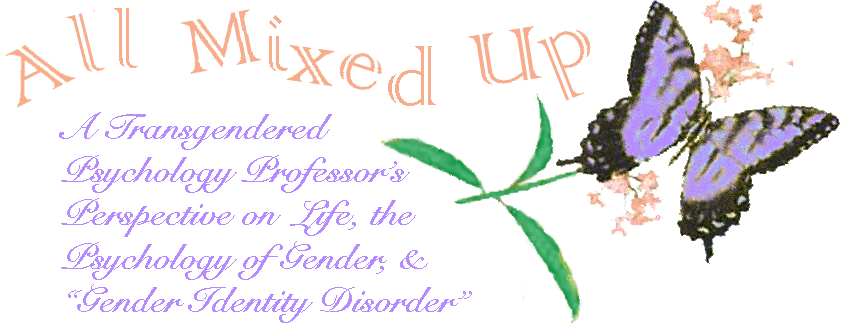
|
|

|
After Anne Lawrence popularized autogynephilia with her essay "Men Trapped in Men's Bodies", it became a topic on many discussion lists. As one of the few psychologists on transgendered mailing lists (e.g., Trans-Theory) and one of the few transgendered members of psychology mailing lists (e.g., Sexnet), I ended up discussing autogynephilia way too much. From my posts over several years, I compiled this critique of Blanchard's model.
Citation: Wyndzen, M. H. (2003). Autogynephilia and Ray Blanchard's mis-directed sex-drive model of transsexuality. All mixed up: A transgendered psychology professor's perspective on life, the psychology of gender, & "gender identity disorder". Available: http://www.GenderPsychology.org/autogynpehilia/ray_blanchard/
This is page 1 (above links) & 13 (below links) of 13. [1] [2] [3] [4] [5] [6] [7] [8] [9] [10] [11] [12] [13]
I first read Ray Blanchard's scientific papers on autogynephilia and transsexuality years ago. This was before Anne Lawrence web-published her first essay, "'Men Trapped in Men's Bodies': An Introduction to the Concept of Autogynephilia" on the topic and long before J. Michael Bailey published his book "The Man Who Would Be Queen: The Science of Gender Bending and Transsexualism." That is, I am one of the few transsexuals who first formed an opinion of the scientific work surrounding this theory before any exposure to these more general-audience accounts. Thinking back, this probably has a more startling influence on my interpretations than you might imagine.
I am a part of two communities that are deeply touched by the way this theory has been raised, supported, and challenged. Both communities mean a great deal to me and I feel the tension surrounding this topic has escalated in a very unhealthy way for both communities. The transsexual community needs to be treated with dignity, as full persons with the depth of many dimensions to our experiences. The scientific psychology community needs to be free to follow our data wherever it may lead us and we should not be made to feel bad, as though doing something harmful, when our goal is simply to find out and understand the complex world of mental phenomena.
I hope I can convey what the scientific data say as well as what is really something else: clinical intuitions separate from any scientifically valid conclusion. What follows is a summary of the key points in Blanchard's mis-directed sex-drive model of transsexuality along with a scientific critique. I hope I can allay some of the fears many transsexuals now feel and provide students of psychology an additional perspective on what Blanchard's findings say and mean.
Blanchard's model is not supported by the empirical data. Blanchard's model assumes the very things it seeks to prove by assigning transsexuals to types and by a peculiar definition of gender dysphoria. Blanchard's model extends beyond the data available. In particular, correlations do not reveal causality. Three key methodological issues make it difficult to interpret Blanchard's data: a selection bias in defining gender incongruence, failure to include necessary control groups, and failure to account for age. This does not mean that every aspect of Blanchard's work is incorrect. As noted above using Blanchard's own data, it is likely that all types of transsexuals do have occasional sexual fantasies about being their target sex. What this means remains unclear and is a promising area for future research.
Ray Blanchard offers a provocative scientifically-testable account for the development of transsexuality. He deserves praise for being one of the few researchers willing to offer a possible explanation. By offering his explanation he has generated considerable data that any subsequent theory will need to account for. My hope is that subsequent theories will take into account the richness of transsexuals' experiences: our experiences as children, being assigned gender roles by society, handling gender stereotypes, fitting into related groups like the GLB community, our desires to be competent members of society, our desires to form meaningful human relationship, and our sexuality. So little is known about transsexuality, yet understanding transsexuality can help us understand all people.
This is page 1 (above links) & 13 (below links) of 13. [1] [2] [3] [4] [5] [6] [7] [8] [9] [10] [11] [12] [13]
|
|
|